Before the tiny settlement of Rome became “Rome,” a great civilization ruled practically the whole peninsula that is now known as Italy.
This was the Etruscan civilization, a long-gone civilization whose accomplishments paved the way for the emergence of ancient Roman art and culture and the Italian Renaissance.
Although their presence is relatively unknown today, the Etruscans were the first “superpower” of the Western Mediterranean, developing the first genuine cities in Europe alongside the Greeks.
They were successful to such an extent that the most significant towns in contemporary Tuscany (Florence, Pisa, and Siena) were founded by the Etruscans and have been continually inhabited since.
The Etruscans are sometimes labeled “mysterious” or “enigmatic” since none of their history or literature survived.
This is especially ironic given that the Etruscans were in charge of teaching the Romans the alphabet and spreading literacy over the Italian peninsula.
In other words, the Etruscan civilization was an early civilization that occupied Italy from Tuscany to Rome (900 BCE-100 BCE).
It was mostly forgotten and barely recognized until archaeological finds showed strength, intricacy, and sophistication. As such, the Etruscans developed a distinct civilization and culture.
Moreover, they also made an essential contribution to European history by shaping the early growth of Rome in numerous ways.
Many of the most distinguishing elements of Roman civilization were inspired or directly adopted from the Etruscans.
Subsequently, the Etruscans significantly impacted Rome, as seen by its religion, culture, urban design, and engineering.
They also helped establish it as a great metropolis and one of Italy’s most remarkable powers. One must first comprehend the Etruscan effect on the Early Roman Republic to comprehend Rome.
What impact did the Etruscans have on the Roman economy?
Content
By the 8th century, when Rome was created, the Etruscans had formed multiple city-states that had developed agriculture, craft, and commerce, which served as a foundation for the development of the Roman economy. They exchanged goods with the tribes surrounding them.
What did the Etruscans bring with them to Rome?
The Etruscans laid the groundwork for a tremendous impact on ancient Roman civilization, and the Romans acquired many of their own cultural and artistic traditions, including gladiatorial fighting, hydraulic engineering, temple construction, and religious ritual, among other things.
What did the Etruscans become famous for?
The Etruscan civilization thrived in central Italy between the eighth and third centuries BCE. During antiquity, this civilization was most prominent for its vast mineral riches.
The civilization was a powerful Mediterranean hub. However, much of its culture and history were either annihilated or incorporated into the civilization of its conqueror, Rome.
History of the Etruscans
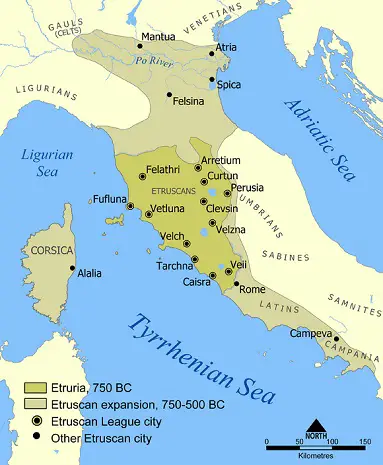
The Etruscans lived in Tuscany and northern Lazio in ancient Italy and thrived in this region from 1000 BCE until 100 BCE. A martial aristocracy presided over a substantial rural populace.
This changed over time as the Etruscans grew more intelligent and wealthy, and oligarchies began to rule Etruria.
The Etruscans’ riches were founded on their abundant natural resources. Etruria was wealthy in copper and gold, and mines dot the countryside.
The Etruscans were also highly well-versed in technology, and they were well-known for their metallurgy and ceramic talents. They were also accomplished, sculptors and painters.
Furthermore, the Etruscans were also skilled sailors who traveled across the western Mediterranean.
They came into touch with Greek and Punic civilizations beginning in the 7th century BCE, and many Greeks moved to Etruria.
The Greeks and the Etruscans

The Etruscans battled the Greeks for control of the sea passages. The Etruscans were never a unified political entity. They were never unified political entities.
Nonetheless, the different Etruscan city-states were unique. The seaside cities were often more cosmopolitan than the inland ones.
By the 7th century BCE, many Etruscan city-states had formed a loose political and military alliance.
Likewise, the Etruscans were mighty warriors who imitated Greek Hoplite tactics and equipment. This enabled them to control a vast portion of Italy, from the Po Valley to the Naples region.
Only the Greek city-states of Magna Graecia (southern Italy) stood up against their Italian soldiers.
The Etruscans could capture Rome, and their influence was so significant that a Tarquinii dynasty of Etruscan rulers dominated the city for most of the 6th century BCE.
During this time, the city of Rome flourished fast, and it is conceivable that many Etruscans settled there.
Similarly, the Romans and the Etruscans were culturally and ethnically distinct. The first residents of Rome were Latins who spoke an early version of Latin.
During the reign of the Tarquinii kings, Rome was a part of the Etruscan world and was heavily impacted by it.
The Etruscans experienced political and economic deterioration beginning in the fifth century BCE. Northern Celtic tribes attacked Etruria and sacked numerous towns.
The Greeks destroyed the Etruscan ships in the Battle of Cumae and began to control the sea channels, causing an economic downfall in many Etruscan states.
The Etruscan League of City-States was severely weakened as a result. This allowed the Romans to evict the Etruscan dynasty while also unifying the Latin peoples of central Italy.
In like manner, the Etruscans also had long traded with the Greeks, and their alphabet was based on theirs.
The city-states of Etruria had long been influenced by Greek culture. The Tarquin rulers of the Etruscans introduced Greek culture to the Romans.
Many Roman aristocracies sent their kids to Etruscan towns to attend schools where they learned Greek and explored its literature and philosophy.
Greek thinking and literature contributed to the enrichment of Roman civilization as well.
The Romans took the Greek alphabet and utilized it for their language, Latin. Much of Roman literature was also based on Greek forms and genres.
Greek ideas also influenced Roman political thinking and philosophy. Many male aristocracies could speak Greek by the second century BCE, and many were educated in Athens.
The Etruscans against Rome and the Celtic Raiders
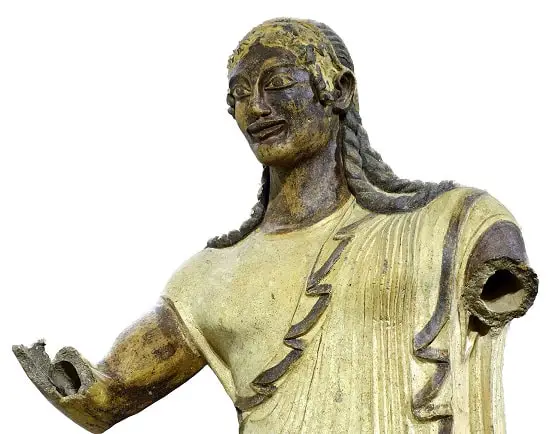
The Etruscans were continuously harassed by Celtic invasions and incursions from the north, and they were under pressure from Rome from the south. For roughly 150 years, Rome and the Etruscans were at odds.
With the development of sophisticated military, Rome was more able to beat the Etruscans in war.
After a protracted siege, the Romans conquered the important Etruscan city of Veii in 406 BCE, allowing Rome to push into Etruria.
Many years of peace existed between the Romans and the Etruscans, and they even periodically collaborated against the Celts.
At the Battle of Sentium in 295 BCE, the Roman soldiers destroyed a coalition of Etruscan states. The Romans capitalized on their advantage, capturing three significant Etruscan city-states in a single year (280 BCE).
Likewise, Cerveteri also fell in 273 BCE, and it was the last autonomous Etruscan city-state.
When the Romans built military colonies in Etruria, a process of Romanization started, and Etruscan civilization began to fade.
Sulla and his troops destroyed several Etruscan towns during his battle with Marius. By 50 BCE, the Etruscans had vanished entirely from history, and it seems that they had been Romanized.
The Etruscan Impact on Ancient Rome
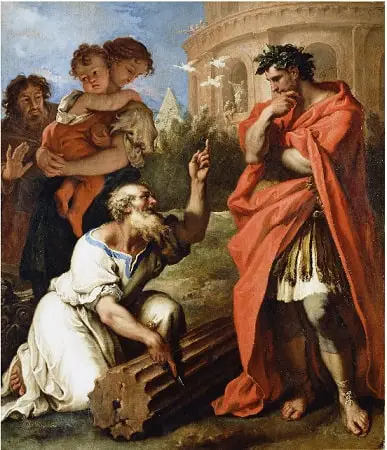
The Etruscans took control of Rome, which was nothing more than an impoverished community of shepherds and small farmers, circa 650 BCE.
The location of Rome appealed to the Etruscans because it was built on a series of hills that were simple to defend.
Rome was also close to an essential ford in the Tiber. Some salt factories were nearby, which were a valuable economic asset in the ancient world.
The Etruscans seem to have taken absolute control of the city, although it is hard to know what is a myth and truth in this age.
Similarly, the Tarquinii were the Etruscan rulers that governed the city. Tarquinius Priscus was the first Etruscan king of Rome, succeeding the last Latin ruler.
He was an ambitious and warlike ruler who enlarged Rome’s borders.
Later, he was killed by a Roman nobleman. Servius Tullius was the next king, and he was a capable leader. He elevated Rome to the top of the Latin league and made it the most powerful organization in central Italy.
The later rulers of Rome are depicted as ruthless tyrants in the chronicles of Livy and others. Because of his tyranny and savagery, the last Etruscan king was banished.
As mentioned, the Etruscans had a significant impact on ancient Roman civilization.
The Romans received many of their own cultural and aesthetic traditions from the Etruscans, including gladiatorial fighting, hydraulic engineering, temple construction, and religious ritual, among other things.
In reality, hundreds of years after the Etruscans were defeated and integrated into the Roman empire, the Romans kept an Etruscan priesthood in Rome (which they felt essential to consult while under siege from invading “barbarians”).
We even derive the word “person” from the Etruscan mythological figure Phersu — the terrifying, masked figure seen in Early Etruscan tomb paintings which would engage his victims in a dreadful “game” of bloodletting to appease the deceased’s soul (the original gladiatorial games).
To elaborate, the Etruscan religion had an unforeseen impact on Rome, which was the establishment of gladiator competitions.
Many Etruscan city-states seem to have made it a norm to compel men to fight to the death at the burial of a noble or monarch.
The males often battled to the death, and the fallen fighter’s blood was sacrificed to the deities of the underworld. This habit seems to have been adopted by the Romans during the Tarquin monarchs’ reign.
The Romans secularized the practice of men fighting. However, specific religious symbolism remained, such as the appearance of an attendant costumed as the deity Hermes.
Over the years, the Romans transformed what was primarily an Etruscan sacred festival into a bloody public sports event.
Similarly, even though a non-Roman family ruled most cities, i.e., the Etruscans, the city increased in strength and status. The Etruscans ensured that the Romans ruled over the Latin people.
This, together with the land gained by the Etruscan rulers, was crucial in the growth of Rome, and these monarchs established the groundwork for the eventual Roman dominance of Italy.
They left an indelible mark on Rome’s power symbols. The fasces (bundle of sticks) and the ax were derived from Etruscan regal emblems.
These were eventually adopted by Republican Rome and were a part of the city’s ceremonial life until the emergence of the Papacy after the collapse of the Roman Empire.
Contribution of Etruscan Kings to Roman Development
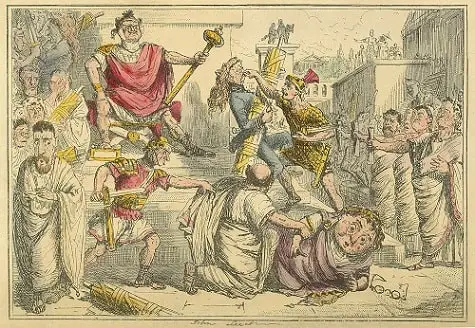
The Etruscan rulers were master builders, transforming Rome from the chaos of huts and modest homes into a genuine metropolis.
The king most likely brought Etruscan builders and architects into the city. The Etruscans were brilliant engineers and master builders.
The Romans learned a lot from the Etruscans, and the legendary Roman competence in urban design and engineering began with their northern neighbors under the Tarquinii reign.
The Etruscans profoundly affected Roman architectural design under the Roman Republic.
The Tarquinii rulers built a line of sewers throughout Rome, making the city more sanitary and allowing it to flourish and thrive.
The rulers also drained many of the marshes surrounding the city throughout time, allowing more land to be farmed to feed Rome’s burgeoning population.
Many of the most notable structures and public works may be dated back to the Etruscan period.
The city grew significantly, necessitating the construction of other walls to safeguard the populace. The Tarquins erected the Servian Walls and fortified several of the city’s other hills.
The Servian Walls were finally built as a single defense encircled the whole city. These walls were so expertly constructed that they safeguarded the city for hundreds of years.
The Etruscans also constructed numerous well-known temples, including the Temple of Jupiter.
They also have brought the vault and the arch into Roman architecture. They are also primarily recognized for constructing Rome’s first Forum, its central public area.
The Impact of Etruscan Religion on Roman Religion
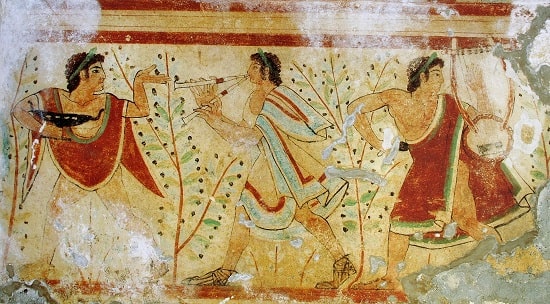
Little is known about the nature of the Etruscan religion. However, numerous authors have labeled it as “dark.” The full extent of Etruscan religion and mythology’s effect on Rome will never be discovered.
Some Etruscan deities and demons seem to have been adopted by the Romans. These demons were later passed down to Christians.
Similarly, the Etruscans were also famous for their prophesies and oracles. One of the Tarquin kings obtained the Syballine writings from an Etruscan sanctuary, which became Rome’s prophetic literature.
Oracles were also an essential aspect of Roman religion. Many of these oracles were of Etruscan origin, referred to as the Haruspices.
This was the skill of understanding God’s will. Etrurian soothsayers were also in high demand, and their abilities seemed to have been handed down to local Roman priests.
The Etruscan soothsayers were said to comprehend the Gods’ will by viewing natural phenomena such as lightning. Examining the internal organs of sacrificial animals was another Etruscan way of determining the Gods’ wants.
One of the most unusual Etruscan practices was observing how particular holy hens ate their meal to comprehend the divine intent.
Even after the Etruscan rulers were exiled, the Romans honored the Etruscan oracles. The Roman Senate decreed that the state perpetuated the Etruscan oracles and rites, and Roman priests performed them until the Christian period.
The Impact of the Etruscans on Ancient Roman Sanitation
Around 500 BC, the Etruscans constructed Rome’s first subterranean sewers. These deep tunnels under the city’s streets were constructed of exquisitely cut stones, which the Romans took use of when they conquered the city.
These constructions thereafter became the standard in a large number of cities throughout the Roman world. Sewer galleries did not go under every roadway or region. However, as per historians like Lina Zeldovich, in other cities, especially Rome, the length and width of the major sewer, the Cloaca Maxima, surpasses that of many modern cities’ main sewage systems.
Archaeological evidence indicates that their intricately built sewage systems were designed to drain standing water rather than to remove filthy trash. Sanitation in ancient Rome, gained from the Etruscans, was advanced in comparison to other ancient cities, providing citizens with water and sanitation facilities.
These early drainage systems consisted of subterranean canals designed to move rainfall away from areas where it may wash away topsoil. Additionally, ditches were utilized to drain wetlands such as the Pontine Marshes, and marshy channels were drained using underground canals.
Drainage systems developed gradually and were first used largely to drain marshes and storm runoff. Sewers were primarily used to remove surface and subsurface water. The sewage system as a whole did not improve much until the introduction of the Cloaca Maxima, an open waterway that was eventually covered and one of the most well-known ancient sanitary artifacts.
The majority of sources date its construction to the sixth century BC, during the rule of the three Etruscan kings. Originally, Rome’s “largest sewer” was constructed to drain the low-lying ground around the Forum. According to some researchers, there is insufficient information to adequately establish the Cloaca Maxima’s usefulness.
However, some academics claim that the Cloaca Maxima conveyed one million pounds of human waste and water. Other sewers were constructed concurrently with the creation of the Cloaca Maxima, with many of them being connected.
Conclusion
The Etruscans were the Romans’ forefathers in many respects. They had a wide-ranging impact on the fledgling city-state.
The civilization of the Etruscans introduced the Romans to Greek concepts and new religious practices.
The Etruscans taught the Romans engineering and construction techniques. They also had a significant impact on the classical Roman architectural style.
They also improved the city’s economy, for example, by draining the marshes near Rome.
The age of the Etruscan rulers is sometimes represented as one of oppression. Yet, these kings enlarged the city and its area, elevating it to the position of dominant power in central Italy.
The Etruscans may have opened the way for the Romans to become a power in Italy and the Mediterranean.

What made Etruria a Superpower was the mastery of metallurgy. The Elba island has iron mines (the main city and port of the island in “portoferraio” the iron port). The coast of Tuscany had smelters for the metallurgical industry, near Piombino. Mastery of metals is what made Etruria a superpower. The Villanovan Civilisation (the proto-Etruscan) dates to 900 BC and the proto-Villanovans date to 1200 BC in Northern Italy. Western Civilization and culture started in Northern Italy with the Proto-Villanovans. Mastery of Metallurgy gave them technological power in warfare and the “Sea Peoples” of 1200 BC are Proto-Villanovans testing their metal sword in their raiding and conquering. It was not a famine that caused the collapse of 1200 BC : it was a technological revolution in metallurgy!!!
Of the 7 kings of Rome, 3 were Etruscan and 2 are clearly identified as Etruscan by their names: Tarquinius Priscus and Tarquinius Superbus, are clearly linked to the major Etruscan city of Tarquinia. And for the first two centuries of the Republic, most of the consuls were of Etruscan ethnicity. Early Rome was clearly Run by Etruscans!